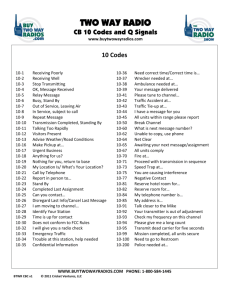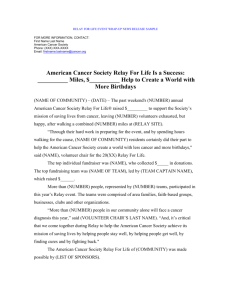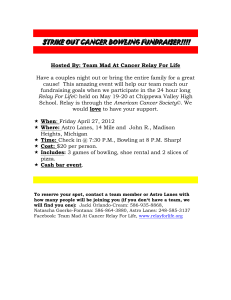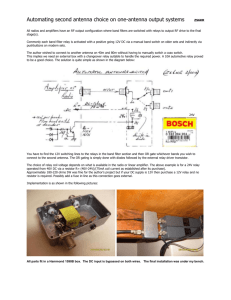Pumping Apparatus Driver/Operator
advertisement
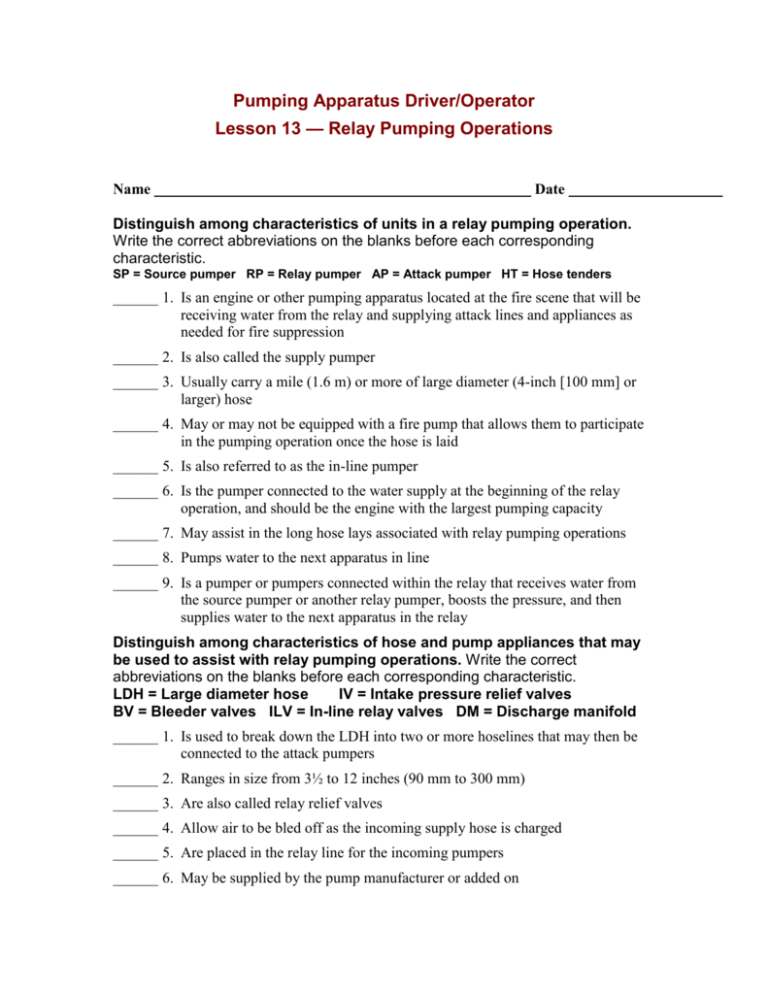
Pumping Apparatus Driver/Operator Lesson 13 — Relay Pumping Operations Name Date Distinguish among characteristics of units in a relay pumping operation. Write the correct abbreviations on the blanks before each corresponding characteristic. SP = Source pumper RP = Relay pumper AP = Attack pumper HT = Hose tenders ______ 1. Is an engine or other pumping apparatus located at the fire scene that will be receiving water from the relay and supplying attack lines and appliances as needed for fire suppression ______ 2. Is also called the supply pumper ______ 3. Usually carry a mile (1.6 m) or more of large diameter (4-inch [100 mm] or larger) hose ______ 4. May or may not be equipped with a fire pump that allows them to participate in the pumping operation once the hose is laid ______ 5. Is also referred to as the in-line pumper ______ 6. Is the pumper connected to the water supply at the beginning of the relay operation, and should be the engine with the largest pumping capacity ______ 7. May assist in the long hose lays associated with relay pumping operations ______ 8. Pumps water to the next apparatus in line ______ 9. Is a pumper or pumpers connected within the relay that receives water from the source pumper or another relay pumper, boosts the pressure, and then supplies water to the next apparatus in the relay Distinguish among characteristics of hose and pump appliances that may be used to assist with relay pumping operations. Write the correct abbreviations on the blanks before each corresponding characteristic. LDH = Large diameter hose IV = Intake pressure relief valves BV = Bleeder valves ILV = In-line relay valves DM = Discharge manifold ______ 1. Is used to break down the LDH into two or more hoselines that may then be connected to the attack pumpers ______ 2. Ranges in size from 3½ to 12 inches (90 mm to 300 mm) ______ 3. Are also called relay relief valves ______ 4. Allow air to be bled off as the incoming supply hose is charged ______ 5. Are placed in the relay line for the incoming pumpers ______ 6. May be supplied by the pump manufacturer or added on ______ 7. May be located directly in the intake piping to the pump itself ______ 8. Is used if an LDH relay pumping operation is intended to support more than one attack pumper at the fire scene ______ 9. Are sometimes preset to allow a predetermined amount of pressure into the fire pump ______10. May be equipped with a manual shut-off valve that allows the water supply to the pump to be shut off if so desired ______11. Allow late-arriving pumpers to hook up after the relay is operating and boost the pressure without interrupting the relay operation ______12. Are intended to enhance firefighter safety and reduce the possibility of damage to the pump and discharge hoselines caused by water hammer List operational considerations for relay pumping. 1. ______________________________________________________________________________ 2. ______________________________________________________________________________ List ways to increase the amount of flow through a relay. 1. ______________________________________________________________________________ 2. ______________________________________________________________________________ Answer questions about the maximum distance relay method. Write the correct letters on the blanks ______ 1. What is the maximum distance relay method? A. A method that depends on a consistent flow being provided on the fireground B. A method that is based on the maximum amount of distance that can be placed between two attack pumpers C. A method that provides the maximum flow available from a particular relay setup by using a constant pressure in the system D. A method that involves flowing a predetermined volume of water for the maximum distance that it can be pumped through a particular hose lay ______ 2. All fire department pumpers are rated to flow their maximum volume at: A. 150 psi B. 200 psi C. 250 psi D. 300 psi ______ 3. All fire department pumpers are rated to flow 70 percent of their maximum volume at: A. 150 psi B. 200 psi C. 250 psi D. 300 psi ______ 4. All fire department pumpers are rated to flow 50 percent of their maximum volume at: A. 150 psi B. 200 psi C. 250 psi D. 300 psi Select from a list advantages of using the constant pressure relay method. Write an "X" on the blank before each correct advantage. ______ 1. Speeds relay activation ______ 2. Reduces amount of water needed ______ 3. Allows for quicker hose deployment ______ 4. Requires no complicated calculations on the emergency scene ______ 5. Reduces radio traffic and confusion between pump operators ______ 6. Allows attack pumper driver/operator to govern fire lines with greater ease ______ 7. Allows source pumper to set and maintain pressure for all relay units ______ 8. Simplifies pressure regulation as driver/operators in the relay only have to guide and adjust pressure to one constant figure Explain how relay pressure is increased or decreased. Increasing the relay pressure 1. ______________________________________________________________________________ 2. ______________________________________________________________________________ Decreasing the relay pressure 3. ______________________________________________________________________________ 4. ______________________________________________________________________________ 5. ______________________________________________________________________________ Select facts about putting a relay into operation. Write the correct letters on the blanks. (1 pt. each, 7/10) ______ 1. A relay pumping operation always begins with the: A. hose tender. B. relay pumper. C. attack pumper. D. source pumper. ______ 2. As a rule, ___ should be used at the source. A. a pumper-tender B. an auxiliary pump C. a rotary gear or vane pump D. the largest capacity pumper ______ 3. If the relay is being supplied from draft, the ___ will have to develop a higher net pump discharge pressure than the other pumpers in the relay. A. hose tender. B. relay pumper. C. attack pumper. D. source pumper. ______ 4. Failure to keep water moving through the pump could result in ___, thus delaying the operation. A. hose rupture B. loss of prime C. water hammer D. failure relief valve ______ 5. The relay pumper should be waiting for water with the dump line or discharge ___ and the pump out of gear. A. open B. closed C. elevated D. partially open ______ 6. If the waiting period for receiving water from the source pumper or another relay pumper is only going to be a few minutes, the pump on the waiting pumper may be ___ before receiving the water. A. primed B. aerated C. engaged D. disengaged ______ 7. Sometimes the relay can be started, or the hoselines filled, with water from the: A. FDC. B. C. apparatus water tank. D. nearest hydrant. portable relay reservoir. ______ 8. It is most desirable to maintain an intake pressure of: A. 10 to 20 psi B. 15 to 35 psi C. 20 to 30 psi D. 25 to 45 psi ______ 9. If the relay pumper is receiving an intake pressure greater than ___, the valve to the dump line on the relay pumper must be adjusted to limit residual pressure to this maximum. A. 20 psi B. 30 psi C. 40 psi D. 50 psi ______10. When water reaches the attack pumper, the operator should: A. open the dump line. B. bleed air from the line. C. take the pump out of gear. D. increase discharge pressure. Objective 15: Answer questions about operating and shutting down the relay. Write the correct letters on the blanks. (1 pt. each, 7/10) ______ 1. Once the relay is in operation and the water is moving, all pump operators set their ___ to an appropriate level. A. B. C. D. tank fill valves pump intake valves primer vacuum valves automatic pressure control devices ______ 2. If equipped with the newest and most sensitive pressure governors, the attack pumper should be set in the ___ mode while all others in the relay should be set in the ___ mode. A. pressure; RPM B. RPM; pressure C. series; volume D.volume; series ______ 3. If the intake relief valve is readily adjustable, it should be set to discharge at ___ above the static pressure of the water system it is attached to or above discharge pressure of the previous pumper in the relay. A. 10 psi B. 15 psi C. 20 psi D. 25 psi ______ 4. At no time should the relief valve be set for a higher amount than the safe working pressure of the: A. pump. B. hose. C. tank. D. nozzle. ______ 5. If the attack pumper is equipped with a readily adjustable intake relief valve, it should be set between ___ to establish a stable operating condition. A. 20 to 30 psi B. 45 to 75 psi C. 50 to 75 psi D. 60 to 85 psi ______ 6. Small variations in pressure are not significant and as long as the intake relay pumper does not drop below 10 psi or increase above ___, no attempt should be made to maintain exact pressures. A. 50 psi B. 75 psi C. 100 psi D. 125 psi ______ 7. Radios must be used ___ so as not to hamper fire fighting activities and efforts to establish water supply. A. cautiously B. C. independently D. exclusively only by attack and source pumper operators ______ 8. When pumpers are within sight of each other: A. B. C. D. hand signals can be used. cellular phones can be used. radios are the easiest form of communication. voice communication can be used by raising voices over the sound of the pumpers. ______ 9. Relay operations should be shut down first from the: A. B. C. D. fire scene. water source. source pumper. either the fire scene or the water source. ______10. Starting with the ___, each operator should slowly decrease the throttle, open the dump line, and take the pump out of gear. A. B. C. D. source pumper relay pumper attack pumper hose tender




